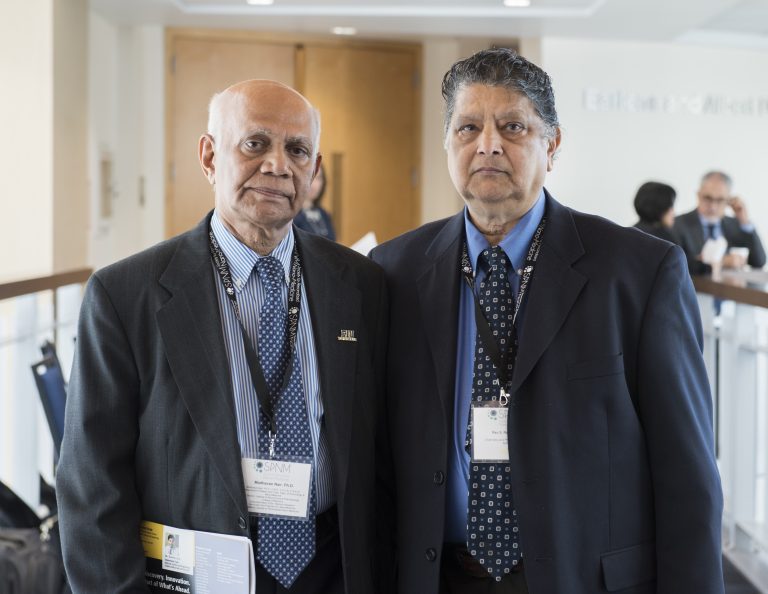The Society for Personalized Nano-Medicine’s 5th Annual Personalized Nano-Medicine Symposium brought 130 of the top basic, translational and clinical researchers from around the nation to FIU on Nov. 1, including a surprise guest, Dr. Robert Sackstein, who will take the reins as the new dean of FIU’s Herbert Wertheim College of Medicine in January.
Sackstein stopped by to briefly welcome the distinguished guests to the symposium along with Dr. John A. Rock, the College of Medicine’s founding dean who is stepping down after 11 years. The meeting was founded in 2013 by Madhavan Nair, distinguished professor and chair of the Department of Immunology and Nano-Medicine and director of the Institute of NeuroImmune Pharmacology.
With more than 45 presentations ranging from regenerative nano-medicine based on rare earth particles to personalized biofabrication of tissue, the annual symposium has become an important meeting for the country’s top nanotechnology researchers to learn about the novel research being undertaken by their peers.
Nano research at FIU
FIU’s investigators shared their work on the development of unique nano-formulations targeting HIV reservoirs in the brain; the use of multifunctional nano-therapeutics for the treatment of opioid addictions; the molecular dynamic docking studies for treating neurocognition impairments; and other research.
“Our Department is heavily focused on finding nano-based solutions for a host of challenging conditions and diseases — including substance abuse, Alzheimer’s, HIV/AIDS and Zika,” said Nair.
“The FIU HWCOM has, through the leadership of Dr. Nair, established a preeminent position in applying nanotechnology to medical practice,” says Sackstein. “Nanotechnology offers the exciting opportunity to deliver therapeutic molecules to target tissues with high efficiency, eliminating side effects and ushering forth the era of precision in personalized treatments.”
Combating opioid addiction
Many of the studies featured at the symposium in the past have led to new medications, technologies and clinical techniques. Among the topics discussed this year were different approaches to combating opioid addiction and substance abuse through a new National Institutes of Health/National Institute on Drug Abuse initiative called HEAL, Help to End Addiction Long-Term. NIDA has been supporting these research efforts for decades, explains Rao S. Rapaka, branch chief of the Chemistry, Pharmacology and Physiological Systems Research Branch in the Division of Neuroscience and Behavior, but it recently received increased support from Congress, which he says will enable “an aggressive, trans-agency effort to speed scientific solutions.”

And there has already been progress, Rapaka points out.
“People aren’t dying of heroin overdoses because of Narcan.” Narcan, or naloxone, works by blocking or reversing the effects of opioids. Available as an injection or nasal spray, nanotechnology enabled researchers to increase the amount of active medicine in the formulation, which has been critical in reversing overdoses.
But there are escalating threats from new synthetic opioids and heroin imported from other countries, including an extremely dangerous drug from Thailand called Kratom which experts warn will require even a stronger Narcan or equivalent to have any impact.
Studies supported by NIDA presented at the conference include targeting molecules that can form a base for non-habit forming anti-chronic pain therapeutics; identifying and creating analogues of hormones that have been shown to decrease the preference for morphine and the development of safer, non-habit forming opioid analgesics for chronic treatment, among others.
“We need to help those who suffer from chronic pain as well as those who develop opioid use disorder,” says Rapaka. “We cannot focus only on drugs—we must integrate medicines with behavioral treatments and therapies because this is not just one problem and therefore it requires more than one solution.”







